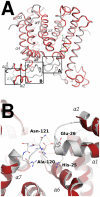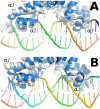The binding of triclosan to SmeT, the repressor of the multidrug efflux pump SmeDEF, induces antibiotic resistance in Stenotrophomonas maltophilia
- PMID: 21738470
- PMCID: PMC3128119
- DOI: 10.1371/journal.ppat.1002103
The binding of triclosan to SmeT, the repressor of the multidrug efflux pump SmeDEF, induces antibiotic resistance in Stenotrophomonas maltophilia
Abstract
The wide utilization of biocides poses a concern on the impact of these compounds on natural bacterial populations. Furthermore, it has been demonstrated that biocides can select, at least in laboratory experiments, antibiotic resistant bacteria. This situation has raised concerns, not just on scientists and clinicians, but also on regulatory agencies, which are demanding studies on the impact that the utilization of biocides may have on the development on resistance and consequently on the treatment of infectious diseases and on human health. In the present article, we explored the possibility that the widely used biocide triclosan might induce antibiotic resistance using as a model the opportunistic pathogen Stenotrophomonas maltophilia. Biochemical, functional and structural studies were performed, focusing on SmeDEF, the most relevant antibiotic- and triclosan-removing multidrug efflux pump of S. maltophilia. Expression of smeDEF is regulated by the repressor SmeT. Triclosan released SmeT from its operator and induces the expression of smeDEF, thus reducing the susceptibility of S. maltophilia to antibiotics in the presence of the biocide. The structure of SmeT bound to triclosan is described. Two molecules of triclosan were found to bind to one subunit of the SmeT homodimer. The binding of the biocide stabilizes the N terminal domain of both subunits in a conformation unable to bind DNA. To our knowledge this is the first crystal structure obtained for a transcriptional regulator bound to triclosan. This work provides the molecular basis for understanding the mechanisms allowing the induction of phenotypic resistance to antibiotics by triclosan.
Conflict of interest statement
The authors have declared that no competing interests exist.
Figures









Similar articles
-
Structural and functional analysis of SmeT, the repressor of the Stenotrophomonas maltophilia multidrug efflux pump SmeDEF.J Biol Chem. 2009 May 22;284(21):14428-38. doi: 10.1074/jbc.M809221200. Epub 2009 Mar 26. J Biol Chem. 2009. PMID: 19324881 Free PMC article.
-
The biocide triclosan selects Stenotrophomonas maltophilia mutants that overproduce the SmeDEF multidrug efflux pump.Antimicrob Agents Chemother. 2005 Feb;49(2):781-2. doi: 10.1128/AAC.49.2.781-782.2005. Antimicrob Agents Chemother. 2005. PMID: 15673767 Free PMC article.
-
Cloning and characterization of SmeT, a repressor of the Stenotrophomonas maltophilia multidrug efflux pump SmeDEF.Antimicrob Agents Chemother. 2002 Nov;46(11):3386-93. doi: 10.1128/AAC.46.11.3386-3393.2002. Antimicrob Agents Chemother. 2002. PMID: 12384340 Free PMC article.
-
Triclosan: a widely used biocide and its link to antibiotics.FEMS Microbiol Lett. 2001 Aug 7;202(1):1-7. doi: 10.1111/j.1574-6968.2001.tb10772.x. FEMS Microbiol Lett. 2001. PMID: 11506900 Review.
-
Mechanisms of antimicrobial resistance in Stenotrophomonas maltophilia: a review of current knowledge.Expert Rev Anti Infect Ther. 2020 Apr;18(4):335-347. doi: 10.1080/14787210.2020.1730178. Epub 2020 Feb 21. Expert Rev Anti Infect Ther. 2020. PMID: 32052662 Review.
Cited by
-
The impact of DNA adenine methyltransferase knockout on the development of triclosan resistance and antibiotic cross-resistance in Escherichia coli.Access Microbiol. 2020 Nov 18;3(1):acmi000178. doi: 10.1099/acmi.0.000178. eCollection 2021. Access Microbiol. 2020. PMID: 33997609 Free PMC article.
-
Bacterial Multidrug Efflux Pumps at the Frontline of Antimicrobial Resistance: An Overview.Antibiotics (Basel). 2022 Apr 13;11(4):520. doi: 10.3390/antibiotics11040520. Antibiotics (Basel). 2022. PMID: 35453271 Free PMC article. Review.
-
Antimicrobials and Food-Related Stresses as Selective Factors for Antibiotic Resistance along the Farm to Fork Continuum.Antibiotics (Basel). 2021 Jun 4;10(6):671. doi: 10.3390/antibiotics10060671. Antibiotics (Basel). 2021. PMID: 34199740 Free PMC article. Review.
-
The intrinsic resistome of bacterial pathogens.Front Microbiol. 2013 Apr 30;4:103. doi: 10.3389/fmicb.2013.00103. eCollection 2013. Front Microbiol. 2013. PMID: 23641241 Free PMC article.
-
Selection for Antimicrobial Resistance in Foodborne Pathogens through Exposure to UV Light and Nonthermal Atmospheric Plasma Decontamination Techniques.Appl Environ Microbiol. 2020 Apr 17;86(9):e00102-20. doi: 10.1128/AEM.00102-20. Print 2020 Apr 17. Appl Environ Microbiol. 2020. PMID: 32111590 Free PMC article.
References
-
- Aiello AE, Larson EL, Levy SB. Consumer antibacterial soaps: effective or just risky? Clin Infect Dis. 2007;45(Suppl 2):S137–147. - PubMed
-
- De Muynck W, De Belie N, Verstraete W. Antimicrobial mortar surfaces for the improvement of hygienic conditions. J Appl Microbiol. 2010;108:62–72. - PubMed
-
- Moretro T, Sonerud T, Mangelrod E, Langsrud S. Evaluation of the antibacterial effect of a triclosan-containing floor used in the food industry. J Food Prot. 2006;69:627–633. - PubMed
-
- Jones RD, Jampani HB, Newman JL, Lee AS. Triclosan: a review of effectiveness and safety in health care settings. Am J Infect Control. 2000;28:184–196. - PubMed
-
- Sjoblom M, Ainamo A, Ainamo J. Antimicrobial effect of four different toothpastes. Scand J Dent Res. 1976;84:377–380. - PubMed
Publication types
MeSH terms
Substances
Associated data
- Actions
- Actions
LinkOut - more resources
Full Text Sources
Medical

